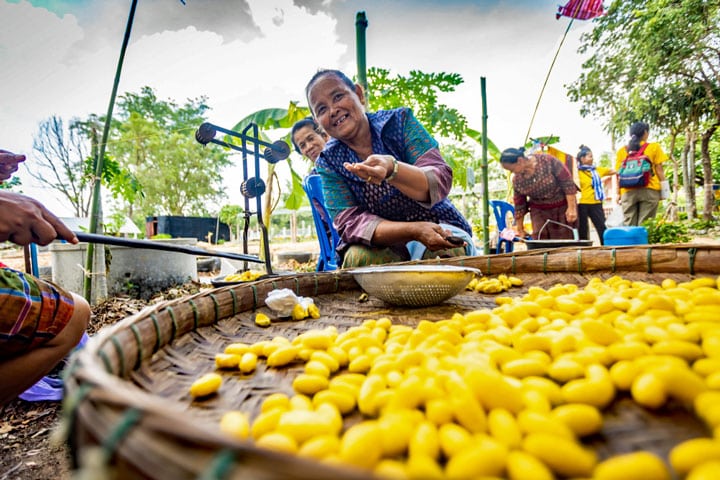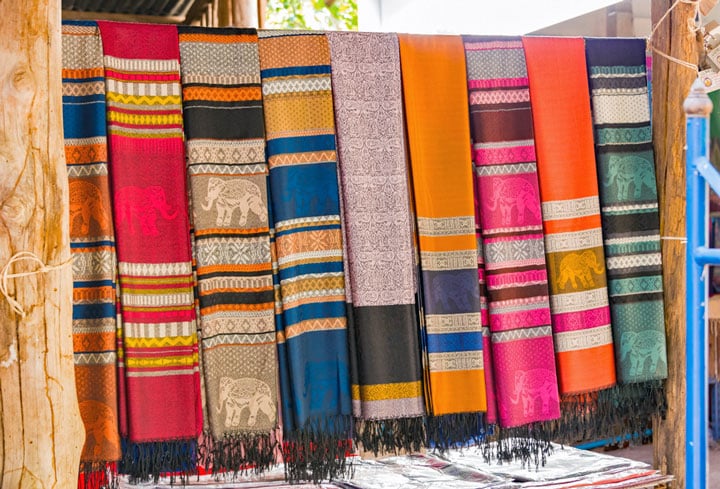Silk weaving mill near Surin

Silkworms in Surin (athurstock / Shutterstock.com)
Surin is of course primarily known for its elephants. The annual elephant festival is especially favourable Thai and other tourist attractions.
Yet there is another reason why Surin should be mentioned: the silk industry. The concentration of caterpillar farms in this province can probably be explained by the fact that the soil here is extremely suitable for the mulberry tree. And silkworms prefer to eat the leaves of this tree.
Ban Tha Sawang
I decide to spend a day visiting a silk farm. According to the manuals I should be in the village of Ban Tha Sawang, seven kilometers west of the city of Surin, so towards Buriram. We find this difficult, but on the road to Buriram we see a large billboard indicating such a farm. Here we can follow the whole process.
Because I don't like to give up on a planned plan, we ask where Ban Tha Sawang is located. We can find this village on a road slightly to the north, also to the west. Once there, we mainly find shops. We hardly see any production, but that is probably because all women are currently busy elsewhere. The rice harvest is underway.
silkworm
Everything starts with the silk moth. A butterfly-like creature that lives only a few days, but lays 300-500 microscopic eggs in that short time. After nine days, silkworms appear, which are six centimeters long after three weeks. From this moment on, the caterpillar begins to form a cocoon.

Weaving in Surin (May_Chanikran / Shutterstock.com)
It produces a thread of 12 centimeters per minute and when the caterpillar is completely wrapped, this thread is about 900 meters long. Before the caterpillar becomes a butterfly, humans must intervene. Boiling the cocoon kills the moth and loosens the thread. The doll is eaten. Thais consider it a delicacy, but I remember from many years ago a sickly, almost spoiled taste.
Now the thread, called raw silk, must first be stripped of sericin, a glue-like substance on the outside that served to make a strong cocoon. Then the spinning wheel comes into operation to make a more robust thread. These threads are dyed, in the past with vegetable dyes, but nowadays with chemical products.
Silky smooth
Finally the real weaving. In plain colours, in classic patterns or in beautiful imaginative designs. It is extremely labour-intensive work, which ultimately determines the selling price. Thousands to tens of thousands of Bahts for a sarong or other piece of clothing.
Silk feels soft, supple and pleasant to the touch and has the unique property of cooling when it is warm and warming when it is cold. Furthermore, silk hardly wears and absorbs a relatively large amount of moisture. Silk is naturally dirt-resistant and does not need to be washed often. According to the advertising brochure. Hopefully this old craft will have a long life.



Been a month back in Baan phon, near Amphoe Kham Muang, Kalasin province.
Very impressive to see. I posted pictures of it on my Facebook and got a lot of positive reactions.
I also want to take a look there, it is about 50 km away in Khai Hun.
Where should I be in job phon, for that silk weaving.
Only see a silk shop on Google Maps.
Thanks in advance
Ed
My wife's four sisters and many other villagers also breed silkworms and, unlike Dick, I find it a delicacy. The silk doesn't interest me much but the caterpillars when they are stripped of their silk.... mmm delicious.